M.14(1) – Rotating Platform and Dumbbells
The rotating stool consists of a seat that swivels easily, and can be affected by the changes in moment of inertia caused by two 5 lb weights carried by a person, as well as the precession of a gyroscope. A volunteer sits on a rotating stool holding a 5 lb barbell in each hand. One gives the volunteer a small push that would make him turn slowly, while he keeps his arms fully extended to the sides. When his hands are brought towards his chest the angular velocity increases considerably. If he extends his arms again, he slows down.
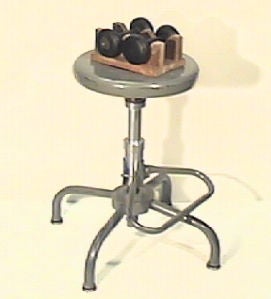
M.14(2) – Bicycle Wheel Gyroscope
A bicycle wheel has a high moment of inertia in comparison with its mass and behaves like a gyroscope, which contributes significantly to the stability of bicycles. Gyroscopic precession can be experienced by holding the spinning wheel while sitting on a platform which is free to rotate.
- The volunteer holds the spinning wheel vertically, and tries to steer himself by tilting the wheel towards a horizontal position. The resulting countertorque will spin him around
- The volunteer holds it horizontally and spins himself, he will rotate in opposite direction to conserve angular momentum
The demonstrations illustrate the vector value of the law of conservation of angular momentum.
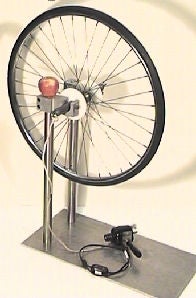
M.14(3) – Tippe-Top
The top consists of a hemisphere and a control stem. When it is spun on a flat surface, it spins on its spherical end for only a few seconds and then, turning upside down, spins on its stem. The motion appears to violate the conservation of energy because it seems to be raising its center of mass without outside help, but because it is spinning, sliding friction force appears. This force creates a torque about the center of mass, causing the top to invert.
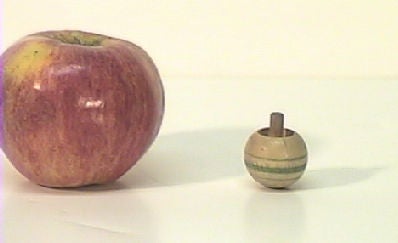
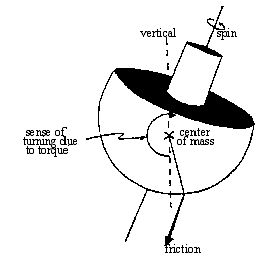
M.14(4) – Governor
Two spheres are attached to rods that are hinged at the other extreme to a post and by its middle to a sphere that slides in this same post. The spheres sit opposing each other on the diameter of a circle, for which the radius can be varied – see the figure. Push this post up and with the two spheres forming a large circle (on the horizontal plane). Then give a small impulse to the spheres. As they rotate around the vertical axis, pull the post down, decreasing the circles diameter. The angular velocities around the axis of rotation increases considerably. If one pushes up the post again it slows down.
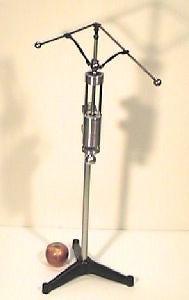
M.14(5) – Rotation of a Non-Homogeneous Sphere
A shere with different moments of inertia along each of its principal axes is suspended on an air bearing. When it is made to spin about the axis with the intermediate moment of inertia, the ball keeps inverting position but the direction of rotation remains the same and momentum is conserved.
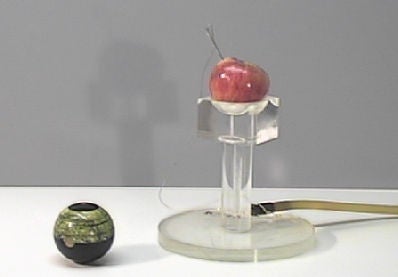
M.14(6) – Maxwell’s Wheel
Used for demonstrating conservation of energy and angular momentum. This unit is basically a large fly wheel suspended by two strong chords. These chords are wound around the shaft of the wheel and then released. The wheel will unwind as it falls but will wind itself back up as the momentum carries the wheel upward in the opposite direction. This oscillation process will continue for several moments as the wheel slowly loses momentum and travels less each time.
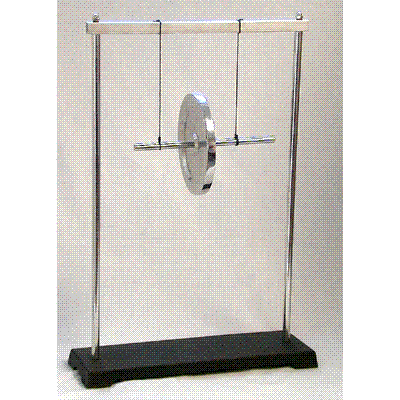
Click here to view a video clip of this demo.
M.14(7) – Galli Cat
In order to demonstrate how a cat can turn over over in mid air and land on its feet without a torque, a mechanical model has been constructed and is demonstrated in the movie linked below. This model was constructed from copper tubing, springs, and other metal parts. When this “mechanical cat” is released from an upside down position with its back to the ground, it flips over to land on its feet. The net torque and the net angular momentum remain zero throughout the entire time.

Click here to see a video of this demo.